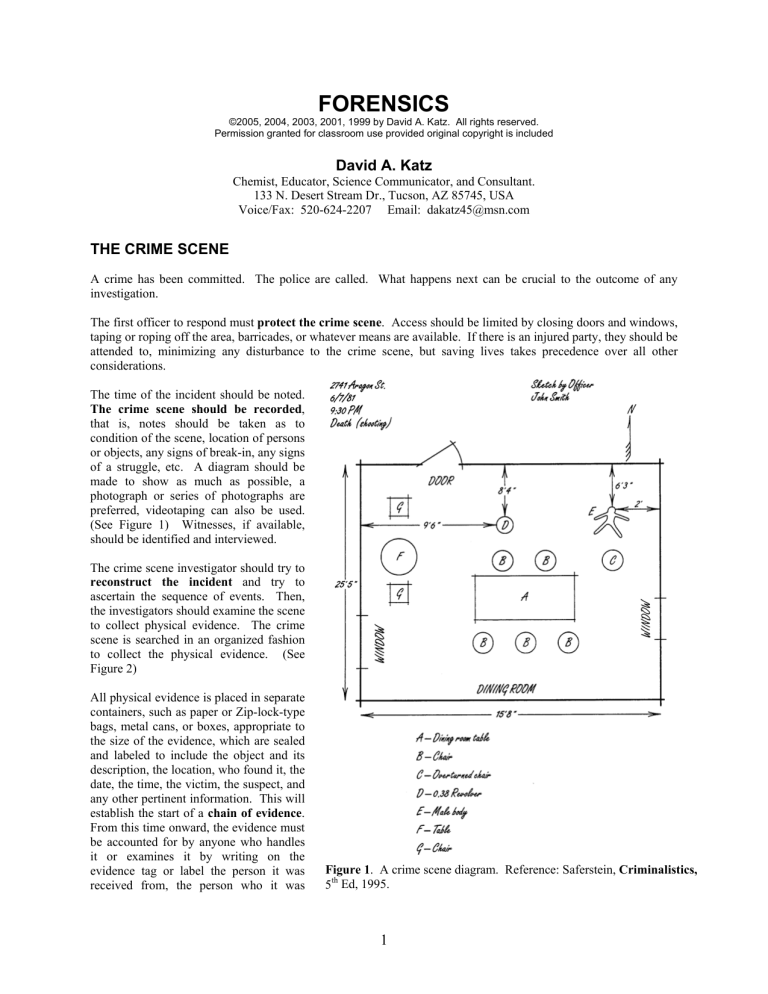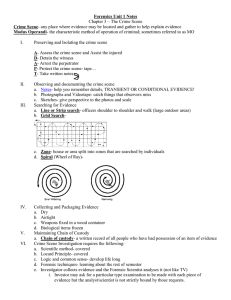FORENSICS

FORENSICS
©2005, 2004, 2003, 2001, 1999 by David A. Katz. All rights reserved.
Permission granted for classroom use provided original copyright is included
David A. Katz
THE CRIME SCENE
Chemist, Educator, Science Communicator, and Consultant.
133 N. Desert Stream Dr., Tucson, AZ 85745, USA
Voice/Fax: 520-624-2207 Email: dakatz45@msn.com
A crime has been committed. The police are called. What happens next can be crucial to the outcome of any investigation.
The first officer to respond must protect the crime scene . Access should be limited by closing doors and windows, taping or roping off the area, barricades, or whatever means are available. If there is an injured party, they should be attended to, minimizing any disturbance to the crime scene, but saving lives takes precedence over all other considerations.
The time of the incident should be noted.
The crime scene should be recorded , that is, notes should be taken as to condition of the scene, location of persons or objects, any signs of break-in, any signs of a struggle, etc. A diagram should be made to show as much as possible, a photograph or series of photographs are preferred, videotaping can also be used.
(See Figure 1) Witnesses, if available, should be identified and interviewed.
The crime scene investigator should try to reconstruct the incident and try to ascertain the sequence of events. Then, the investigators should examine the scene to collect physical evidence. The crime scene is searched in an organized fashion to collect the physical evidence. (See
Figure 2)
All physical evidence is placed in separate containers, such as paper or Zip-lock-type bags, metal cans, or boxes, appropriate to the size of the evidence, which are sealed and labeled to include the object and its description, the location, who found it, the date, the time, the victim, the suspect, and any other pertinent information. This will establish the start of a chain of evidence .
From this time onward, the evidence must be accounted for by anyone who handles it or examines it by writing on the evidence tag or label the person it was received from, the person who it was
Figure 1
5 th
. A crime scene diagram. Reference: Saferstein,
Ed, 1995.
Criminalistics,
1
received by, the date and the time. The chain of evidence must remain in place, with all possession of such evidence accounted for, through to any court hearings or trials.
Figure 2 . Crime scene search patterns. Reference: Saferstein, Criminalistics
Figure 3 . An evidence label
2
COMMON TYPES OF PHYSICAL EVIDENCE
1. Blood, Semen, and Saliva. All suspected blood, semen, or saliva-liquid or dried, animal or human-present in a form to suggest a relation to the offense or persons involved in a crime. This category includes blood or semen dried onto fabrics or other objects, as well as cigarette butts that may contain saliva residues. These substances are subjected to serological and biochemical analysis for determination of identity and possible origin. Blood and semen stains may be made visual by using an ultraviolet lamp.
2. Documents. Any handwriting and typewriting submitted so that authenticity or source can be determined. Related items include paper, ink, indented writings, obliterations, and burned or charred documents.
3. Drugs. Any substance seized in violation of laws regulating the sale, manufacture, distribution, and use of drugs.
4. Explosives. Any device containing an explosive charge, as well as all objects removed from the scene of an explosion that are suspected to contain the residues of an explosive.
5. Fibers. Any natural or synthetic fiber whose transfer may be useful in establishing a relationship between objects and/or persons.
6. Fingerprints. All prints of this nature, latent and visible.
7. Firearms and Ammunition. Any firearm, as well as discharged or intact ammunition, suspected of being involved in a criminal offense.
8. Glass. Any glass particle or fragment that may have been transferred to a person or object involved in a crime.
Windowpanes containing holes made by a bullet or other projectile are included in this category.
9. Hair. Any animal or human hair present that could link a person with a crime.
10. Impressions. This category includes tire markings, shoe prints, depressions in soft soils, and all other forms of tracks. Glove and other fabric impressions, as well as bite marks in skin or foodstuffs, are also included.
11. Organs and Physiological Fluids. Body organs and fluids are submitted for toxicology to detect possible existence of drugs and poisons. This category includes blood to be analyzed for the presence of alcohol and other drugs.
12. Paint. Any paint, liquid or dried, that may have been transferred from the surface of one object to another during the commission of a crime. A common example is the transfer of paint from one vehicle to another during an automobile collision.
13. Petroleum Products. Any petroleum product removed from a suspect or recovered from a crime scene. The most common examples are gasoline residues removed from the scene of an arson, or grease and oil stains whose presence may suggest involvement in a crime.
14. Plastic Bags. A polyethylene disposable bag such as a garbage bag may be evidential in a homicide or drug case.
Examinations are conducted to associate a bag to a similar bag in the possession of a suspect.
15. Powder Residues. Any item suspected of containing firearm discharge residues.
16. Serial Numbers. This category includes all stolen property submitted to the laboratory for the restoration of erased identification numbers.
17. Soils and Minerals. All items containing soil or minerals that could link a person or object to a particular location. Common examples are' soil imbedded in shoes and safe insulation found on garments.
3
18. Tool Marks. This category includes any object suspected of containing the impression of another object that served as a tool in a crime. For example, a screwdriver or crowbar could produce tool marks by being impressed into or scraped along a surface of a wall.
19. Vehicle Lights. Examination of vehicle headlights and taillights is normally conducted to determine whether a light was on or off at the time of impact.
20. Wood and Other Vegetative Matter. Any fragments of wood, sawdust, shavings, or vegetative matter discovered on clothing, shoes, or tools that could link a person or object to a crime location.
Reference: Fisher, Techniques of Crime Scene Investigation ,
4
SUSPECT IDENTIFICATION
The identification of a suspect in a crime used to require a police artist who would try to construct a picture of that suspect from witness descriptions. The police artist is still useful, but much of the routine construction of a composite picture can be accomplished on a computer using FACES™ software. This software is currently in its
4.0 version. The FACES interface is shown in Figure 4.
Figure 4 . The FACES interface from FACES 3.0
Suspect Identification
Become familiar with the faces software. Try to construct the face of a friend, relative, or one of your classmates.
A suspect will enter the room at some point during the class session. Can you reconstruct the suspect’s face?
5
References:
The following books are the most useful references for forensics that I have found.
Saferstein, Richard, Criminalistics , 7 th
Ed., Prentice Hall, 2001
My favorite book on forensics. If you only buy one book, this is the book to buy. I think it gets better with each edition. Gives a general overview with lots of case examples. This is a book you can read cover-to-cover.
Meloan, Clifton, Richard James, and Richard Saferstein, Lab Manual for Criminalistics , 6 th
Ed., Prentice
Hall, 1998
Lab techniques for forensics. Not totally self explanatory. It is helpful to have some previous laboratory experience.
Fisher, Barry A. J., Techniques of Crime Scene Investigation , 6 th
Ed., CRC Press, 2000
This is the book often preferred for introductory courses in forensic programs. As the title indicates, this book focuses on the techniques and procedures of crime scene investigation. This book should be a part of your library on forensics.
White, Peter, Editor, Crime Scene to Court, The Essentials of Forensic Science , The Royal Society of
Chemistry, 1998.
This book explains the methods and techniques used in crime scene investigations and forensic laboratories in the United Kingdom.
There is an excellent series of five short articles that appeared in Chemistry in Britain , May 1993, which explain the basics of toxicology, material evidence, microscopic examination, drugs, and DNA analysis.
Baden, Michael, M.D., and Marion Roach, Dead Reckoning: The New Science of Catching Killers ,
Simon & Schuster, 2001.
Dr. Baden is an internationally known forensic pathologist. This book is a “best seller” overview of autopsies, murder scenes, blood-splatter analysis, the life cycles insects in human remains,
DNA fingerprinting and the methods for identifying unknown victims by their skulls, teeth and bones. The book is interesting to read and quite informative.
Rainis, Kenneth G., Crime-Solving Science Projects, Forensic Science Experiments , Enslow Publishers,
Inc., 2000.
Forensic science projects suitable for classroom activities and for students for science fairs.
Includes projects on physical evidence, fingerprints, document examination, blood evidence, and hair and fiber examination.
Software:
FACES™ (Currently in Version 4.0), InterQuest Inc.
This software allows you to construct the face of a suspect from a friendly user interface. You can choose to work in English, French, or Spanish. With the popularity of forensics, the price of this program doubled in recent years. Shop all the forensics and science education vendors you can find to locate the best price.
6
A Source for Forensic Supplies:
There are a number of sources for forensic supplies. The names and addresses can be located on the
Internet. The company I have been using is:
Criminal Research Products, Inc.
Now owned by Tri-Tech Inc.
4019 Executive Park Blvd., SE
Southport, NC 28461
Telephone: 800-438-7884
Web site: www.tritechusa.com
OR www.criminalresearchproducts.com
In addition, most of the science supply companies that sell educational materials are now selling various forensic science kits. Most of these supplies and kits tend to be expensive. My suggestion is to buy some forensics books, learn about techniques, study the supply catalogs, and assemble your own home-made kits using locally available materials.
7




